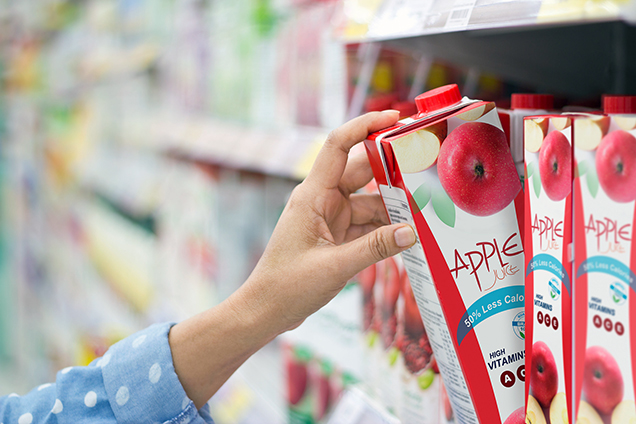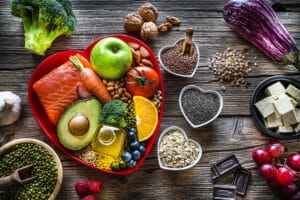Navigating the grocery store can be a challenge, especially when it comes to reading foods labels and deciphering between healthy foods and unhealthy foods.
Are the nutrition facts on your cereal box or favorite foods lying to you? That may sound like a silly question, but between food additives, hidden ingredients, and baseless marketing lingo on food packaging and nutrition labels, it’s not such a far-fetched idea. The truth is, most people struggle to eat healthy because they don’t know the secret language of food labels. Perhaps they don’t know how to read the nutrition labels fully, or don’t know what to look for. Or maybe they wouldn’t suspect a “health food” to make a false claim or deceive them.
Eating healthy may be more complicated these days, but it’s simple when you know the secrets behind the labels. Here, we’ll show you some of the major pitfalls of food labels and how you can learn to shop smarter to live better.
Biggest Modern Diet Challenges

Despite the push to eat healthier and the myriad of wellness resources available to us, America is still struggling to change our eating habits and live healthier. With busy schedules and picky eaters, fast food is an easy go-to. So easy, in fact, that studies show that over ⅓ of Americans eat fast food on any given day.
Even if you know the importance of eating a healthy diet, staying on track can seem impossible. Those who try to make the right choices are often sabotaged by tricky labels, hidden additives, and unnecessary amounts of fat and sugar.
The way we grow and cultivate our food has also changed drastically over the past several decades. Pesticides are used in high amounts to make food grow bigger and faster to increase profit. The hybridization of ancient grains has created high-performing modern wheat that’s nothing like what our ancestors ate. Genetically modified foods (GMO) are taking over classic heirloom varieties.
While our addiction to junk food, sugar, and abundance might be great for business, it’s not so good for our bodies. Our adult obesity rates have grown past 40% (with childhood obesity around 20%), and millions of Americans fight debilitating, chronic, yet preventable diseases caused by unhealthy lifestyles.
Here’s the good news: we can shift our current health trends and make better choices for ourselves now and in the future. The path to healthier days starts with understanding what we’re eating and looking at nutrition facts on the label.
Understanding Nutrition
It’s time to get smart about food. And that starts with food label clarity. We need to understand what our modern foods are made of, the meaning behind their marketing, and how to recognize the good foods from the bad.
Fats: the Good, Bad, and the Ugly

Fat can either be friend or foe, depending on the kind of fat you’re eating. While trans fats and saturated fats have been shown to cause issues like obesity and heart disease, other fats (like omega-3s) are essential to our health. In fact, healthy fats help to improve brain health, mood, focus, and even reduce inflammation and pain.
When reading food labels and looking for ways to boost your diet, focus on healthy fats, then reduce and avoid the damaging fats.
- Include Healthy Fats: salmon, mackerel, sardines, flaxseeds, chia seeds, walnuts, and canola oil.
- Limit or Reduce Saturated Fat: animal fat, whole-milk dairy foods, cheese, butter, and coconut oil.
- Avoid Trans Fat: shortening, microwave popcorn butter, hydrogenated oils, margarine, fried fast foods, and artificial non-dairy creamers.
Sugars: Sweeten Life with Better Choices

Got a sweet tooth? If so, your relationship with sugar might be giving you more problems than cavities alone. Sugar is an addictive and inflammatory food that is linked to a wide range of chronic health issues. Unfortunately, avoiding sugar is more complicated than cleaning out your candy cupboard. Sugar is one of the most common additives in processed foods – both sweet and savory.
While it’s difficult to rid your life of sugar completely, knowing how to read nutrition labels can help you choose healthier sweeteners and reduce your overall sugar intake. Look for and avoid these types of added sugar: High-fructose corn syrup, cane sugar or juice, maltose, dextrose, invert sugar, rice syrup, molasses, caramel. Instead, try swapping traditional sugar for healthier options like stevia, honey, coconut sugar, agave, or raw cane sugar. These pose less of a problem than refined sugar, but moderation is still key.
Salts: Where are They Hiding?

When it comes to protecting your heart and preventing cardiovascular disease, reducing your sodium intake is an important step. Salt isn’t inherently bad. It enhances the taste of our food and is even required by our bodies to maintain proper homeostasis. But overdoing it on the salt is easy to do and it quickly becomes too much of a good thing. Eventually, too much sodium in the diet can cause issues like high blood pressure, stroke, and heart failure.
So, how can we limit our salt intake to protect our hearts? It’s not enough to simply sprinkle less salt on your dinner. Sodium is hiding in high amounts in nearly every kind of fast food or processed food. To make sure you’re keeping your sodium levels within a healthy range, avoid eating frozen meals, canned or pickled foods, deli meats, cheese, condiments, sauces, dressings, processed breads and cakes, cereals, and sodas. Check the nutritional labels on all foods to see the percentage of daily sodium intake that item has.
The best way to manage your salt intake is to cook for yourself whenever possible. You’ll be able to use just the right amount of salt and include other flavorful herbs and spices to enhance your dish in a healthy way. When cooking, opt for sea salt or Himalayan salt. These have lower sodium content than table salt and contain healthy minerals.
Common Nutrition Label Claims Disguised as “Healthy”

Sadly, you can’t always read a book by its cover when it comes to food. Marketing and advertising play a major part in how we perceive a certain type of food or product, despite what’s under the packaging. Marketers have become experts at figuring out which terms, words, and phrases make us buy – and that often involves making foods sound healthier than they are.
Don’t be duped by “healthy” marketing lingo. Here’s the meaning behind the most commonly used terms on food packaging and nutrition labels:
All Natural
The word “natural” isn’t regulated by the FDA, which means there are low standards to how it is used. In general, if a food claims it is “natural,” that means it does not contain added colors, artificial flavors, or synthetic materials. That doesn’t, however, mean that it is healthy.
Superfood
While there are some serious “super” foods out there (like berries, dark leafy greens, and certain herbs), the term “superfood” is a marketing term. If you see this on packaged goods, be sure to check the label and make sure it actually does include foods that are rich in vitamins and antioxidants.
Made with Real Fruit
While it might sound healthy, “made with real fruit” just means that fruit juice concentrates have been added. It doesn’t mean that the food is as healthy as fruit, or even contains much fruit. In fact, these foods tend to be high in sugar.

Made with Whole Grains or Multigrain
Like the example above, “made with whole grains” simply means that there are some whole grains present in the food, but it might still contain high amounts of refined grains. Multigrain simply means there is more than one grain present and could include inflammatory grains like corn and white flour. Instead, look for the “100% whole grain” label.
Antioxidant
Antioxidants are amazing for the body. They fight free-radicals and help prevent cellular damage and chronic disease. The trouble happens when not-so-healthy foods include an antioxidant ingredient just so they can claim their food is an “antioxidant.” Instead of falling for the latest “antioxidant soda,” stick to whole foods that you know are rich in antioxidants, like fruits, veggies, and green tea.
Sugar Free
If an item is sugar-free, that means it doesn’t contain refined cane sugar. It may still contain other sweeteners.
Gluten Free
Gluten has been villainized over the past several decades as an inflammatory, disease-causing ingredient. Research has yet to prove whether gluten does impact the gut in a negative way or only affects those with an allergy. Still, many people have transitioned to a gluten-free diet to heal their gut and improve their overall health. Unfortunately, just because a food is gluten-free doesn’t mean that it is healthy for you. Many gluten-free products contain added sugar, flavorings, chemicals, colorings, or other inflammatory grains like corn or soy. Always check the label to get the true picture.
How to Shop Better at the Grocery Store

Shopping for healthy foods shouldn’t be this hard. Thankfully, there are some simple tips we can use to choose healthier options going forward.
1) Read the nutrition labels and stay curious about food.
As you can see, foods aren’t always what they seem. The only way to know what you’re really getting is to buy mostly whole food and learn to read your nutrition labels closely. Here is a quick breakdown of what each piece of information means:
- Serving Size: Amount of food the nutritional info is based on.
- Calories: Energy provided per serving.
- Total Fat: Sum of all fats; includes saturated and trans fats.
- Cholesterol: Amount per serving; affects heart health.
- Sodium: Salt content; impacts blood pressure.
- Total Carbohydrates: Includes fiber and sugars.
- Dietary Fiber: Indigestible carbs; aids digestion.
- Sugars: Total natural and added sugars.
- Protein: Amount per serving; essential for muscle and body function.
- Vitamins and Minerals: Percent of daily recommended values.
- Percent Daily Value (%DV): Contribution to daily diet based on a 2,000-calorie diet.
2) Shop the perimeter.
In general, the healthier, whole foods are located around the perimeter of the store. The interior aisles tend to contain the more processed foods and less-healthy snacks.
Shopping the perimeter of the grocery store is a smart move because this is where you’ll find the freshest options, like fruits, vegetables, dairy, meat, and seafood. These sections are packed with foods that are naturally nutrient-rich and less processed. Fresh produce is loaded with vitamins, minerals, and fiber that are great for your overall health. Lean meats and seafood provide high-quality protein, and dairy products give you essential nutrients like calcium.
On the other hand, the interior aisles are often where the processed foods live. These items are usually higher in added sugars, unhealthy fats, and sodium. They’re made to last longer on the shelf, which often means they’re packed with preservatives and can be pretty calorie-dense without offering much in the way of nutrition.
When you stick to the store’s perimeter, you’re more likely to end up with a cart full of wholesome, nutritious foods that help you maintain a balanced and healthy diet. It’s a simple trick that can make a big difference in your eating habits.
3) Shop local and in-season.
A simple tip for eating well is to buy foods that are grown in your local area and in season. This ensures that you’re getting the absolute best quality foods with deep flavors. You’ll need less salt, sweetener, or flavoring when you can let the raw ingredients shine.
4) Try a new fresh fruit or vegetable each week.
There are some delicious and intriguing fruits and vegetables out there, but we tend to shy away from things that are unfamiliar. Make it a weekly challenge to try something new. Not only will you benefit from new vitamins and minerals, you’ll boost your culinary prowess at the same time!
5) Stick to a plan.
Avoid temptation by creating a weekly meal and snack plan and sticking to the shopping list. When you plan your meals and snacks ahead of time, you have a clear idea of what you need, which makes your shopping trip more efficient. This approach helps you stay focused and reduces the chances of making impulse buys that can derail your healthy eating goals.
Sticking to a plan also means you’re less likely to overspend on unnecessary items. Grocery stores are designed to tempt you with strategically placed products and enticing displays. Without a plan, it’s easy to grab items you don’t really need, which can add up quickly and blow your budget. Having a list based on a well-thought-out meal plan keeps you on track and ensures you’re only buying what you actually need.
The Real Secret: Eat Healthy, Live Vibrantly

The Standard American Diet may be full of hidden secrets but the label tells all. By understanding how to read a nutrition label, avoid hidden additives, and decode deceiving marketing lingo, you’ll be able to shop smarter and start living better.
Need help getting there? Reach out to your local AlignLife Chiropractor for a functional nutrition consultation and guidance on how to create a healthy eating meal plan made for you.



